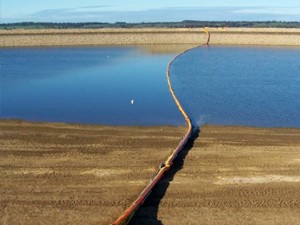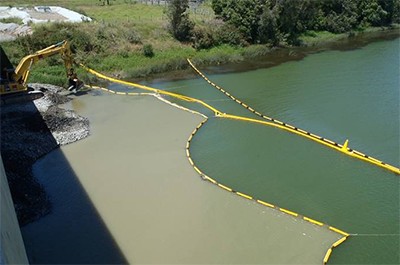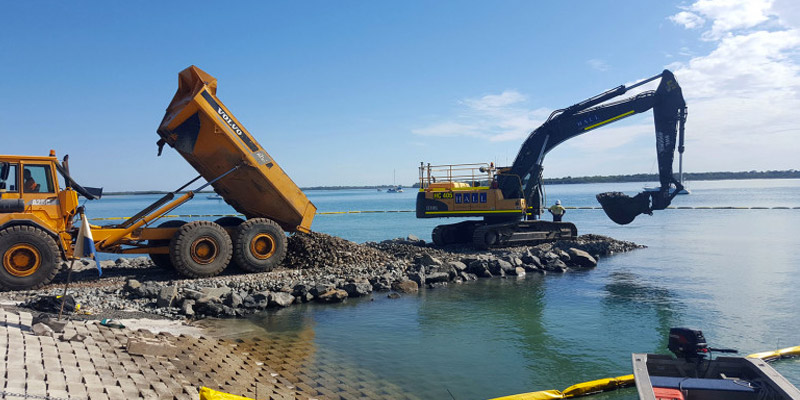nvasive landscape-modifying activities, such as digging, piling, and construction work, inevitably produce particle pollution. Numerous particles of disturbed soil end up in the waterways in the form of suspended sediment, disturbing natural processes and choking out sensitive organisms such as corals. Activities such as dredging create the suspended sediment pollution right within the aquatic ecosystem. Luckily, adequate technical solutions can prevent damage to marine and other ecosystems. Silt curtains are one of the primary tools to contain and control suspended sediment that reaches the water. Learn more about silt curtains’ properties, function, operation and installation.
Many human activities modify and disturb the natural landscape out of necessity. For example, construction is a dominant way humans change the world around them and create their own habitats. Therefore, construction is unavoidable and an integral part of all modern human settlements.
Unfortunately, our natural environment pays a high price for it. As a highly invasive activity, construction and similar industrial activities not only modify and scar the landscape – but also pollute the air, and the water – above and below ground level.
Other activities that require digging, excavation, piling and dredging also contribute to waterway pollution in a similar manner.
How Construction and Excavation Pollute The Waterways?
There are many sources of pollution on building and industrial sites that further contaminate the surrounding environment through soil erosion and surface water runoff (e.g., stormwater). We can distinguish between two types of pollution: chemical and physical.
Chemical Pollution of Waterways
Chemical pollution on construction sites comes from diesel and oil from work machines, solvents, paints, adhesives, corrosion protection, cleaning products, and other chemicals used in construction.
Many of these substances are toxic by nature and can enter both surface waterways and penetrate into the groundwater. The fact that they are either water-soluble or able to float on the water makes them challenging to control.
Physical Pollution of Waterways
Physical or particle pollution is a result of landscape disturbance and damage, often coupled with inert construction material waste. During the process, silt, soil, dirt, and debris travel via runoff and end up in the aquatic environment, where they become suspended in the water. Together, this is known as Sediment pollution.
Whilst not toxic by nature and not able to penetrate into underground aquifers, the suspended particles significantly increase water turbidity. Additionally, fine particles can be carriers of the adsorbed chemicals, which can lead to an overlap between physical and chemical pollution.
Excessive turbidity decreases the penetration of sunlight into the water. Thereby, it impedes vital natural processes – such as photosynthesis – in marine and other aquatic environments. This can have many adverse effects on aquatic organisms across the food web.
Sediment pollution can also smother corals and impact the health of entire coral reefs. The Great Barrier Reef is known to be harshly affected by sediment runoff – although from agriculture sources, with an added chemical dimension. Nevertheless, it can serve as an illustrative example of how not only chemicals, but also particulate matter, can endanger key marine organisms.
Protection from particle pollution is essential when construction and other invasive projects are done along the coastlines.
Because this issue is persistent, Water Quality Guidelines were designed to control it, limiting the amount of specific pollutants allowed released into the marine and other aquatic environments. To comply with the Guidelines, project and site managers need to secure equipment intended to prevent or minimise pollution.
Luckily, companies that specialise in environmental solutions have plenty of them to offer. Silt curtains are one of the main ways to control silt and other suspended particle contamination coming from project sites.

What Is Slit Curtain?
Silt curtains, also known as sediment curtains, turbidity curtains, or silt booms, are partially-floating, partially-submerged, semi-permeable barriers designed to contain the spread of silt and other particle pollution away from the shores and deeper into the aquatic and marine surroundings.
The central part of the curtain is the geotextile skirt, submerged perpendicular to the water surface. Its dimensions can vary depending on the needs of a particular project.
The skirt is kept stable and suspended by floats that sit on the top of the water surface, and the entire construction is kept in place by a suitable anchor system.
How Do Silt Curtains Work?
Silt curtains prevent the spread of silt from the project site into the aquatic environment by creating a physical barrier. The suspended contaminants stop at the barrier and drop down within the water column before settling on the seafloor – their final destination.
Since silt and other particles are not supposed to contain toxic or reactive material, once they reach the seafloor, they will act as inert sediment that doesn’t affect the marine ecosystem in any major way.
The silt curtain also needs to be anchored. Depending on the properties of the aquatic environment, different anchor systems are used.
Phases of silt boom-induced sediment settling are the following:
- Silt curtain deflects the contaminated water towards the bottom of the water body, along with the suspended particles.
- Following the path of least resistance, pure water passes under the curtain.
- The heavier portion of the mix – soil and silt – settles on the bottom (seafloor).
- A portion of water gets filtered through the curtain’s textile material.
- Marine organisms will be able to pass under the curtain carried by the stream of now-sediment-free water.
Despite the clear line between turbid water and clear water that a silt boom creates, it is a semi-permeable structure. Therefore, it doesn’t completely stop the flow of the water – which also means allowing oxygen transfer and movement of marine organisms.
Without a silt curtain, the suspended sediment – and especially the fine particles – would penetrate further into the ecosystems, increasing water turbidity and creating various issues along the way before finally settling. That is why a silt curtain’s main task is to promote sedimentation of the introduced contaminating particles within the contained area and without disturbing the rest of the aquatic system.

Types Of Silt Curtains
There are two main types of silt curtains:
● Standard silt curtains
● Heavy-duty silt curtains
As the name suggests, heavy-duty curtains are intended for use in waterways adjacent to construction sites, mining, larger industrial operations, and rock walls – all of which have the potential to create high-impact suspended particles in large volumes. The heavy-duty curtains’ characteristics are modified compared to the standard silt curtains to withstand the additional pressure.
Silt Curtain Applications
As previously stated, silt curtains can and should be used in all cases where coastal and land disturbance can lead to marine system contamination. These projects include:
- Shoreline and marine construction activities such as building projects, bridges, platform or jetty constructions, etc.
- Same or similar activities on large rivers and at riverbanks.
- Building projects along waterways
- Dredging
- Piling
- Marine excavation
However, if the runoff from the project also contains chemical pollutants, a silt curtain will not contain most of them. In that case, additional interventions and techniques need to be applied.
Pro tip: Silt curtains are sometimes mentioned in the context of containing problematic aquatic vegetation, including weeds and algae. However, although they theoretically can be used for the purpose, silt curtains are not the best option for floating weeds, vegetation, and floating debris control. Because of the small pore size, they can get clogged and go foul. Instead, a special product called weed and debris boom is available.
How To Install a Silt Curtain
Although their construction and functioning is quite straightforward, silt curtains require careful, knowledgeable planning and installation to function property. Expert planning is necessary due to the working environment’s complexity rather than because of the product itself.
Tides, currents, and wind properties are some of the major environmental factors that need to be considered when installing a silt curtain. Other significant factors are the time frame – the projected duration of use – the type of suspended material that needs to be contained, but also the impact of the structure on the local ecosystem and the marine animals that inhabit the area.
As you can imagine, a quite complex algorithm is needed to determine how a silt curtain should be installed at each site.
How much does a silt curtain cost?
The final cost of a silt curtain installation depends mainly on three factors.
- The length of curtain required for the project.
- The type and technical properties of the curtain and the accompanying equipment.
- The environmental factors listed above.
One thing is certain – getting it right the first time is much less costly than modifying the incorrectly planned or installed system.
Besides, the equipment itself, Trade Enviro provides all additional services – including system design and installation – anywhere in Australia. You can count on our expert advice and ingenuity. Reach out today to start the conversation about your ideal silt curtain solution.

